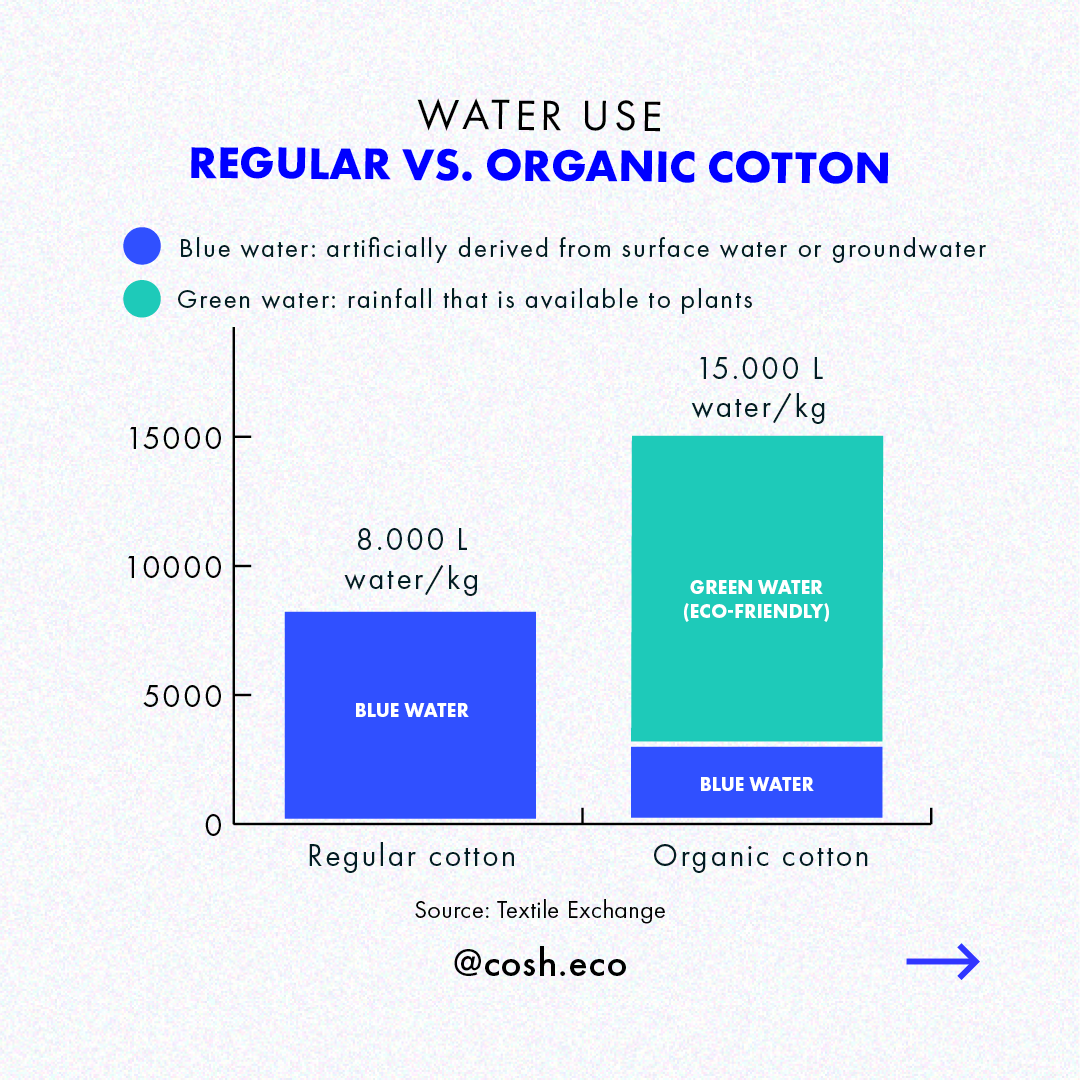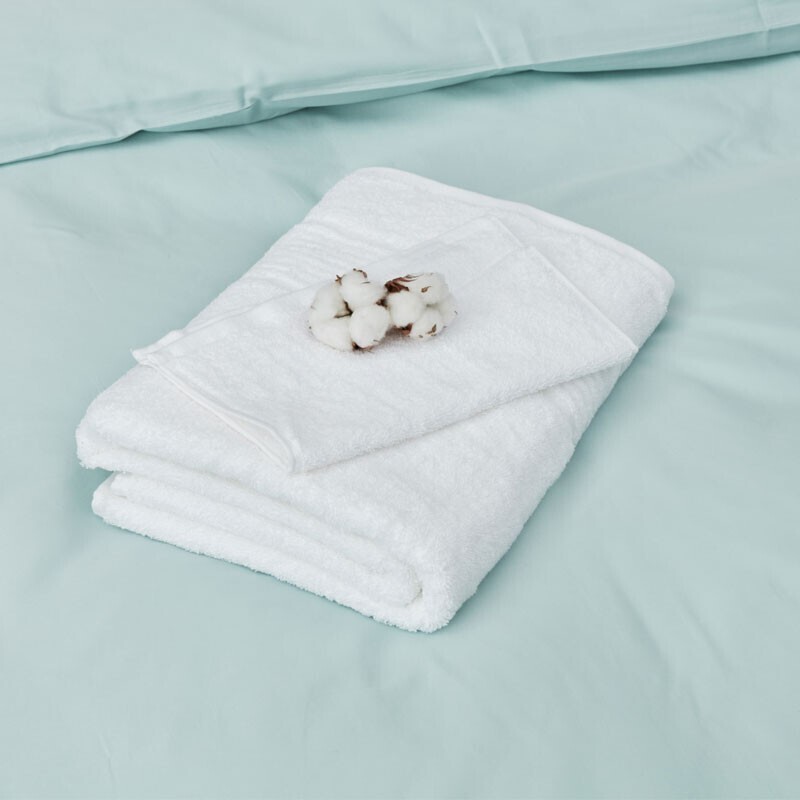
6 November 2025
Sunlight and colour: the hidden drivers of microfiber pollution in the ocean
- Plastics
In our article ‘What impact does cotton have on humankind and the environment?’ you can read about how polluting the traditional cotton industry is. Here at COSH! we’re big fans of organic cotton. In this article you will read about the benefits of organic cotton and how you can make eco-friendly choices for your wardrobe based on labels.

If we compare the production process of traditional and organic cotton (including the weaving and dyeing), we see that producing organic cotton, from plant to product, on average reduces CO2 emissions.
Why is that the case? It’s forbidden to use artificial pesticides and fertilisers when producing organic cotton. Chemicals are a by-product of the polluting oil industry that releases huge amounts of CO2. In addition, organic cotton means healthier soil which absorbs more CO2 from the atmosphere.
Toxic chemicals are forbidden throughout the entire supply chain of organic cotton. Organic farmers are only allowed to use safe substances, such as manure, on their crops. The harvesting and processing of organic cotton is also much safer and done in better work conditions for organic cotton.
With the GOTS-certificate, you know immediately if the fibres or textiles have been dyed in an eco-friendly way. Do you see the Oeko Tex or GOTS certificate? Then you know that the end product cannot contain pesticide or heavy metal residues such as lead and cadmium. This way you know that there are no toxic substances in your clothes. This is good for your skin and the environment!

The cotton plant is on the list of the 10 most water absorbing plants and, out of all textiles, requires the most water. Although the plant does not technically need that much water to grow, the harvest will be very low if there has been a drought. To achieve a good sized harvest, a lot of water is therefore needed. In countries with a lot of rain, the cotton will get its water from rain water (called green water), in drier places, however, water needs to be dispensed via irrigation (blue water) coming from either the ground or surface water. Unfortunately cotton is often still grown in countries with little rain leading to heavy water usage.
But does organic cotton use more water than regular cotton? The answer is complex. There are many conflicting articles about the use of water for the production of organic cotton. In order to analyse this in the right way, it is important to see WHICH KIND of water is used: rain water (green water) or water from the ground (the so-called blue water) and HOW this water is used.
The majority of organic cotton is produced on small farms, that mainly use rain water to irrigate their crops. The healthier ground will also retain the water better. Organic cotton can therefore reduce water usage by 91%. ( Source: The Cotton Center)
Different studies have shown that regular cotton uses 64% more blue water than organic cotton. There is more fresh water taken from the ground when regular cotton is grown than organic cotton. In addition, the chemical sprays used when growing ‘plain’ cotton will strip the soil and pollute the water in the surrounding area, making it unusable for drinking or cooking.
Organic cotton uses natural rain and groundwater resources, absorbs water more and creates less water pollution in the neighbourhood. COSH! concludes that organic cotton uses water more efficiently applies more sustainable agricultural techniques, which will guarantee our future
Do you see the BCI or CmiA certificate attached to an item of clothing on the shop’s shelves?
Know then that these certificates advocate for the reduction of synthetic pesticides and fertilisers. They also promote eco-friendly and water-saving farming practices. An audit carried out in Pakistan found that, thanks to the BCI, the use of pesticides had gone down by 32% – a real success!
What matters as well is that farmers don’t have to pay for their certificate. It’s the brands that absorb this cost through their membership. This makes it easier for small farmers to join without having to make large investments. Today 2% of total cotton production carries the CmiA label and 20% has the BCI label.
Despite their many positive qualities, BCI and CmiA do have their limits. COSH! would rather see a total of artificial chemicals, rather than a simple reduction. Additionally, the BCI cotton label does not guarantee that all the cotton in that garment is BCI.
Here’s a shocking fact: only 10% of all the cotton in a garment must be BCI for that garment to qualify for the BCI-label… the other 90% of the fibres used can be regular polluting cotton. However, in order to be a mamber of the BCI, brands must have the goal that 50% of their cotton will be BCI within 5 years (converted this is only 5% of brand). This essentially means that the BCI label does not guarantee that the labelled product is made from sustainable cotton. BCI and CmiA labels are steps in the right direction, but there is still a long way to go.
Sustainable clothing brands prefer to err on the side of caution and only work with GOTS-certified organic cotton, which bans all toxic chemicals. The use of genetically modified seeds is not permitted with this certificate. Unfortunately, GOTS-certified cotton only accounts for 1% of the total cotton production worldwide. .
In addition to cotton, organic farmers will often grow other crops on their land, allowing them to produce a lower volume of cotton while protecting the environment. Organic cotton farming is more labour intensive and generally yields a lower harvest so it makes sense that organic cotton is more expensive. Here at COSH! though we also pay attention to fair pricing. Wholesalers and intermediaries often try to buy up organic cotton in large quantities at regular cotton prices, without paying a premium. This is very bad for the farmers, but also for the industry at large because it does not incentivise farmers to make the transition to organic cotton meaning there is not enough supply of raw organic cotton.
Looking for the GOTS certificate on your clothes? There are two types of this label:
The GOTS-label certifying over 90% of the fibres are organic.
The GOTS (x%)-label certifying minimum 70% of the fibres are organic.
This means that the label always guarantees that at least 70% of the clothes’ fibres are organic. If this percentage is in between 70% and 95%, then it has to be indicated on the label. When there is no percentage indicated on the label, then over 95% of the product’s fibres are organic.
For certain products such as underwear or socks, the GOTS accepts a small percentage of synthetic fibres, including 8% elastane, to improve their stretch and comfort.
The “Organic Content Standard” (OCS) certificate guarantees consumers that fibres have been treated organically throughout the supply chain. There are two variants of this certificate: OCS 100 and OCS blended. To use the OCS 100 label, the product must consist of 95 – 100% organic cotton and for OCS blended, only 5% of the product’s content needs to be organic.
Only materials coming from certified organic farms (according to one of IFOAM’s families of standards) are accepted by the OCS. This gives organic fibre producers access to the global product market. The certificate works with producers, suppliers, brands and retailers around the world.
However, the report The Great Greenwashing Machine by Veronica Bates Kassatly and Dorothée Baumann-Pauly (read more here) found significant shortcomings. Textile Exchange, which owns the OCS certificate, does not certify cotton. There is no such thing as “TE-certified organic cotton”. The organisation is only concerned about traceability, labelling, post-harvest handling, etc. It does not apply to organic cotton farming. So this certificate is not very accurate because to know if cotton is truly organic, it’s imperative to look at how that cotton has been grown. Textile Exchange cannot guarantee that producers are actually organically farming. The verification of GOTS and OCS certificates is therefore flawed.
Additionally, according to this report, a lot more cotton is sold as organic than the amount of organic cotton produced. Despite the certificates, there will always be some uncertainty about organic cotton.

The Fairtrade cotton label only speaks to the working conditions surrounding the production of cotton – it does not guarantee organic cotton. In most cases, though, the cotton is organic. Fairtrade Belgium told us that 71% of all fairtrade cotton is also organic.
Fairtrade-certified cotton farmers get a fair price for their cotton. Worldwide all Fairtrade farmers receive a price premium of €1,4 million. This translates to just €30 per farm per year… quite low! However,this extra money goes directly to the cooperative the farmers belong to, where it is invested in sustainable agricultural practices, the community or education.
So, unfortunately, fair trade farmers do not get a significant increase in their wages. In order to increase their wages, brands should avoid intermediaries and buy cotton as directly as possible from the farmers. Founder of sustainable home linen brand Kalani, Bruno Van Steenberghe, sets a good example. He decided to pay 13.5% more per kilogram for his organic fair trade cotton and buys directly from the farmers. In this way, Kalani really does give farmers the higher wage that they deserve.

Read also: Which impact does cotton have on humankind and the environment?

6 November 2025

29 October 2025

20 October 2025